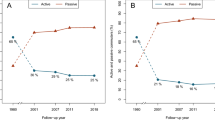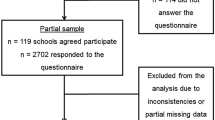Abstract
Objective:
To examine possible associations between active commuting (walking or cycling) to school, parameters of adiposity and lifestyle factors in 14-year-old adolescents of the Kiel Obesity Prevention Study.
Subjects:
A total of 626 14-year-old adolescents.
Methods:
Measured body mass index (BMI), fat mass (FM), distance to school as well as self-reported modes and duration of commuting to school, time spent in structured and unstructured physical activities (PAs), media use, nutrition, alcohol consumption and smoking.
Results:
Parameters of adiposity did not differ between different commuting modes after stratifying by gender. Active commuters reported higher overall PA, which was caused by commuting activity and time spent in unstructured PA in girls and just by commuting activity in boys. In active commuters, 28.4% of overall PA was explained by commuting activity. Additionally, TV viewing was lower in active commuters. Compared to their inactively commuting counterparts, actively commuting boys were less likely to smoke. After controlling for potential confounders the interaction term ‘active commuting by distance to school’ and ‘time spent in structured PA’ were independent predictors of FM, whereas active commuting by itself showed no effect.
Conclusion:
The present data suggest that active commuting to school per se does not affect FM or BMI until considering distance to school. Increasing walking or cycling distance results in decreasing FM. However, the everyday need to get to and from school may enhance adolescents’ overall PA.
This is a preview of subscription content, access via your institution
Access options
Subscribe to this journal
Receive 12 print issues and online access
$259.00 per year
only $21.58 per issue
Buy this article
- Purchase on Springer Link
- Instant access to full article PDF
Prices may be subject to local taxes which are calculated during checkout
Similar content being viewed by others
References
Alexander LM, Inchley J, Todd J, Currie D, Cooper AR, Currie C (2005). The broader impact of walking to school among adolescents: seven day accelerometry based study. BMJ 331, 1061–1062.
Andersen RE, Crespo CJ, Bartlett SJ, Cheskin LJ, Pratt M (1998). Relationship of physical activity and television watching with body weight and level of fatness among children: results from the Third National Health and Nutrition Examination Survey. JAMA 279, 938–942.
Bell AC, Ge K, Popkin BM (2002). The road to obesity or the path to prevention: motorized transportation and obesity in China. Obes Res 10, 277–283.
Bosy-Westphal A, Danielzik S, Becker C, Geisler C, Onur S, Korth O et al. (2005). Need for optimal body composition data analysis using air-displacement plethysmography in children and adolescents. J Nutr 135, 2257–2262.
Cole TJ, Bellizzi MC, Flegal KM, Dietz WH (2000). Establishing a standard definition for child overweight and obesity worldwide: international survey. BMJ 320, 1240–1243.
Cooper AR, Andersen LB, Wedderkopp N, Page AS, Froberg K (2005). Physical activity levels of children who walk, cycle, or are driven to school. Am J Prev Med 29, 179–184.
Cooper AR, Page AS, Foster LJ, Qahwaji D (2003). Commuting to school: are children who walk more physically active? Am J Prev Med 25, 273–276.
Danielzik S, Czerwinski-Mast M, Langnäse K, Dilba B, Müller MJ (2004). Parental overweight, socioeconomic status and high birth weight are the major determinants of overweight and obesity in 5–7-y-old children: baseline data of the Kiel Obesity Prevention Study (KOPS). Int J Obes Relat Metab Disord 28, 1494–1502.
Danielzik S, Pust S, Landsberg B, Müller MJ (2005). First lessons from the Kiel Obesity Prevention Study (KOPS). Int J Obes 29 (Suppl 2), S78–S83.
Dennison BA, Erb TA, Jenkins PL (2002). Television viewing and television in bedroom associated with overweight risk among low-income preschool children. Pediatrics 109, 1028–1035.
DiGuiseppi C, Roberts I, Li L, Allen D (1998). Determinants of car travel on daily journeys to school: cross sectional survey of primary school children. BMJ 316, 1426–1428.
Duke PM, Litt IF, Gross RT (1980). Adolescents’ self-assessment of sexual maturation. Pediatrics 66, 918–920.
Eisenmann JC, Bartee RT, Wang MQ (2002). Physical activity, TV viewing, and weight in U.S. youth: 1999 Youth Risk Behavior Survey. Obes Res 10, 379–385.
Ekblom B, Astrand PO (2000). Role of physical activity on health in children and adolescents. Acta Paediatr 89, 762–764.
Federal Ministry of Transport, Building and Housing (2002). Nationaler Radverkehrsplan 2002–2012. FahrRad! Maßnahmen zur Förderung des Radverkehrs in Deutschland. Available at:http://www.bmvbs.de/Anlage/original_11561/Radverkehrsplan-2002-2012.pdf.Accessed August 1 2006.
Federal Statistical Office Germany (2000). Mikrozensus 2000 – Verkehrsmittel der Schüler und Studenten. Available at:http://www.destatis.de/presse/deutsch/mikro00.htm.Accessed August 1 2006.
Gordon-Larsen P, Nelson MC, Beam K (2005). Association among active transportation, physical activity, and weight status in young adults. Obes Res 13, 868–875.
Grund A, Krause H, Siewers M, Rieckert H, Müller MJ (2001). Is TV viewing an index of physical activity and fitness in overweight and normal weight children? Public Health Nutr 4, 1245–1251.
Hancox RJ, Poulton R (2006). Watching television is associated with childhood obesity: but is it clinically important? Int J Obes 30, 171–175.
Heelan KA, Donnelly JE, Jacobsen DJ, Mayo MS, Washburn R, Greene L (2005). Active commuting to and from school and BMI in elementary school children – preliminary data. Child Care Health Dev 31, 341–349.
INFAS and DIW (Institute for Applied Social Science Research and the German Institute for Economic Research) (2004). Mobilität in Deutschland: Ergebnisbericht. Available at:http://www.kontiv2002.de/pdf/ergebnisbericht_mid_ende_144_punkte.pdf.Accessed August 1 2006.
Kerr J, Rosenberg D, Sallis JF, Saelens BE, Frank LD, Conway TL (2006). Active commuting to school: associations with environment and parental concerns. Med Sci Sports Exerc 38, 787–794.
Lohman TG, Roche AF, Martorell R (1988). Anthropometric Standardization Reference Manual. Human Kinetics Book: Champaign.
Martin S, Carlson S (2002). Barriers to children walking to or from school – United States, 2004. MMWR 54, 949–952.
Mast M, Kortzinger I, Müller MJ (1998). Ernährungsverhalten und Ernährungszustand 5–7-jähriger Kinder in Kiel. Akt Ernähr Med 23, 282–288.
McMillan TE (2005). Urban form and a child's trip to school: the current literature and a framework for future research. J Plan Lit 19, 440–456.
Metcalf B, Voss L, Jeffery A, Perkins J, Wilkin T (2004). Physical activity cost of the school run: impact on schoolchildren of being driven to school (EarlyBird 22). BMJ 329, 832–833.
Müller MJ, Asbeck I, Mast M, Langnäse K, Grund A (2001). Prevention of obesity – more than an intervention. Concept and first results of the Kiel Obesity Prevention Study (KOPS). Int J Obes Relat Metab Disord 25 (Suppl 1), S66–S74.
Owen N, Leslie E, Salmon J, Fotheringham MJ (2000). Understanding environmental determinants of physical activity and sedentary behavior. Exerc Sport Sci Rev 28, 153–158.
Padez C, Mourao I, Moreira P, Rosado V (2005). Prevalence and risk factors for overweight and obesity in Portuguese children. Acta Paediatr 94, 1550–1557.
Pate RR, Baranowski T, Dowda M, Trost SG (1996). Tracking of physical activity in young children. Med Sci Sports Exerc 28, 92–96.
Rosenberg DE, Sallis JF, Conway TL, Cain KL, Mckenzie TL (2006). Active transport to school over 2 years in relation to weight status and physical activity. Obesity 19, 1771–1776.
Sirard JR, Riner Jr WF, McIver KL, Pate RR (2005). Physical activity and active commuting to elementary school. Med Sci Sports Exerc 37, 2062–2069.
Strong WB, Malina RM, Blimkie CJ, Daniels SR, Dishman RK, Gutin B et al. (2005). Evidence based physical activity for school-age youth. J Pediatr 146, 732–737.
Tanner JM (1962). Growth at Adolescence. Blackwell Scientific Publication: Oxford.
Taylor WC, Blair SN, Cummings SS, Wun CC, Manila RM (1999). Childhood and adolescent physical activity patterns and adult physical activity. Med Sci Sports Exerc 31, 118–123.
Telama R, Yang X, Laakso L, Viikari J (1997). Physical activity in childhood and adolescence as predictor of physical activity in young adulthood. Am J Prev Med 13, 317–323.
Timperio A, Ball K, Salomon J, Roberts R, Giles-Corti B, Simmons D et al. (2006). Personal, family, social, and environmental correlates of active commuting to school. Am J Prev Med 30, 45–51.
Timperio A, Crawford D, Telford A, Salmon J (2004). Perceptions about the local neighborhood and walking and cycling among children. Prev Med 38, 39–47.
Tudor-Locke C, Ainsworth BE, Adair LS, Popkin BM (2003). Objective physical activity of Filipino youth stratified for commuting mode to school. Med Sci Sports Exerc 35, 465–471.
Tudor-Locke C, Ainsworth BE, Popkin BM (2001). Active commuting to school: an overlook source of children's physical activity? Sports Med 31, 309–313.
Tudor-Locke C, Neff LJ, Ainsworth BE, Addy CL, Popkin BM (2002). Omission of active commuting to school and the prevalence of children's health-related physical activity levels: the Russian Longitudinal Monitoring Study. Child Care Health Dev 28, 507–512.
US Department of Health and Human Services (2000). Kidswalk-to-School: a guide to promote walking to school. Available at:http://www.cdc.gov/nccdphp/dnpa/kidswalk/pdf/kidswalk.pdf.Accessed August 1 2006.
Wen LM, Orr N, Millett C, Rissel C (2006). Driving to work and overweight and obesity: findings from the 2003 New South Wales Health Survey, Australia. Int J Obes 30, 782–786.
WHO, World Health Organisation (2000). Obesity: Preventing and managing a global epidemic. Report of a WHO Consultation. WHO Technical Report Series: Geneva.
Acknowledgements
This work was supported by grants from Deutsche Forschungsgemeinschaft (DFG 5-1, 5-2, 5-3, 5-5), Wirtschaftliche Vereinigung Zucker, Precon and WCRF UK. Beate Landsberg is supported by a scholarship of the Alfried Krupp von Bohlen und Halbach-Stiftung, Essen, Germany.
Author information
Authors and Affiliations
Corresponding author
Additional information
Guarantor: MJ Müller.
Contributors: BL had the idea of the manuscript, conducted the statistical analyses and drafted the manuscript. SP-D and MJM assisted in writing. BL, SP-D and MJM participated in interpretation and discussion of the data. BL, SP-D, DM, MJ and DL participated in the collection of the data. SP-D and MJM coordinated the study. All author's contributors helped with the revision of the paper.
Rights and permissions
About this article
Cite this article
Landsberg, B., Plachta-Danielzik, S., Much, D. et al. Associations between active commuting to school, fat mass and lifestyle factors in adolescents: the Kiel Obesity Prevention Study (KOPS). Eur J Clin Nutr 62, 739–747 (2008). https://doi.org/10.1038/sj.ejcn.1602781
Received:
Revised:
Accepted:
Published:
Issue Date:
DOI: https://doi.org/10.1038/sj.ejcn.1602781
Keywords
This article is cited by
-
Active mobility—(also) a topic for sport science?
German Journal of Exercise and Sport Research (2024)
-
School-based physical activity in relation to active travel – a cluster randomized controlled trial among adolescents enrolled in the school in motion study in Norway
International Journal of Behavioral Nutrition and Physical Activity (2023)
-
Aktiv zur Schule
Prävention und Gesundheitsförderung (2020)
-
Sedentary behaviors, physical activity behaviors, and body fat in 6-year-old children: the Generation R Study
International Journal of Behavioral Nutrition and Physical Activity (2014)
-
What’s your type: a multidimensional cyclist typology
Transportation (2014)



